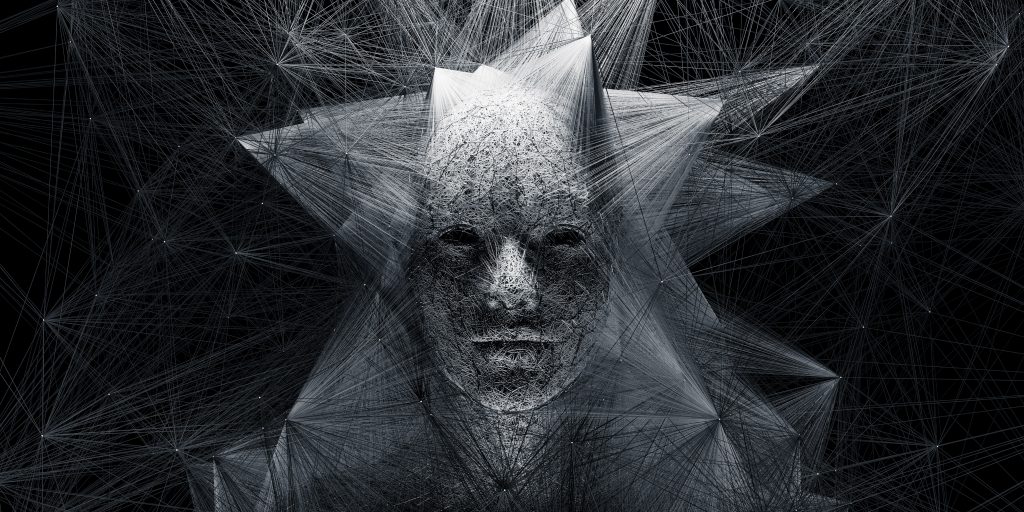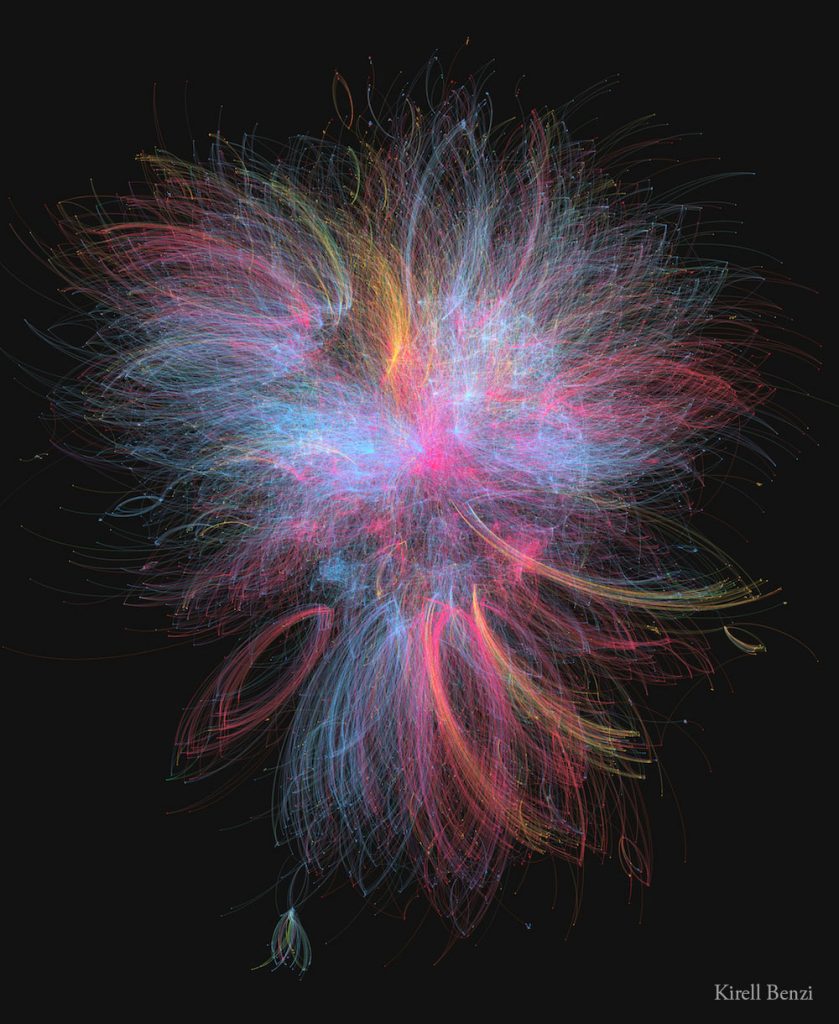5. Datafication, Dataism, and Dataveillance
Adrian Castillo
“[Machine learning models] can evaluate a person better than the average work colleague, merely on the basis of ten Facebook ‘likes.’ Seventy ‘likes’ were enough to outdo what a person’s friends knew, 150 what their parents knew, and 300 ‘likes’ what their partner knew. More ‘likes’ could even surpass what a person thought they knew about themselves”
– Michal Kosinski, Tech by Vice (as cited in Grassegger & Krogeous, 2017)
Figure 8.
The Face of Big Data

In the twenty-first century, the explosion of available data is reshaping our economy and reconfiguring human culture, and eventually, it will transform human nature (Zuboff, 2019b). As big tech encourages people to move their social interactions into digital environments, language is beginning to change.
Think about the words “friending” and “liking.” Both define relations mediated by algorithms. Or the words “followers” and “retweet.” The former defines an online persona through popularity, and the latter the amplification of a thought (Van Dijck, 2014). As a result, participating in digital environments risks turning the language of friendship, which is based on reciprocity and affirmation, into industry-driven language, which quantifies social relations (number of likes, shares, followers, etc) that can be easily mined and repurposed into “precious products” (Van Dijck, 2014, p. 199). The influence that technology has over our lives goes beyond the confines of language, however. Technology is rendering human experiences into data that has never been quantified before; this is a phenomenon called “datafication” (Cukier and Mayer-Schoenberger, 2013).
With that in mind, it is important to clarify that the engine driving datafication is not only our digital interactions but the massive amounts of data we can process, which is known as “Big Data” (Cukier and Mayer-Schoenberger, 2013). Big data helps answer what, not why, due to its hierarchical nature (data, information, knowledge, wisdom) (Strasser and Edwards, 2017). To shed light on that hierarchy, data can be seen as raw material, often unorganized numerical facts which, when organized and combined within a specific context or set of relations, becomes information. In turn, information helps us to create meaning that when brought together with experience assists in decision-making processes, resulting in knowledge. Consequently, the life-long accumulation of knowledge, and crucially, the experience of failure, when examined provides wisdom, which is the “capacity to choose objectives consistent with one’s values within a larger societal context” (Logan, 2014, p.44). Because information is a refinement of basic data, there are huge efforts to transform big data into something humanly comprehensible; these efforts have traditionally included data visualization and machine learning (Mani, 2020).
The following video examines how we use big data and machine learning algorithms in real life:
Open Society Foundations. (2016, December 13). Life in a quantified society [Video]. YouTube. https://www.youtube.com/watch?v=UemXBXgawKY
Data visualization can help us understand Big Data patterns, like in figure # 9, created by the Ph.D. in Data Science and data artist, Dr. Kirell Benzi; the visualization shows how over 20.000 different Star Wars characters connect through their storylines (Benzi 2015):
Figure 9.
The Dark Side and The Light Side

According to Benzi (2015):
- blue nodes: represent all the factions associated with the light side of the Force (Jedis, The Republic, The Rebellion).
- Red nodes: represent all the factions associated with the dark side of the force (the Siths and the Empire)
- Yellow nodes: represent all the factions related to bounty hunters and criminals.
Obviously, big data can also help with other issues like understanding the history of pandemics.
As we have seen in previous chapters, data is collected by close observation (surveillance). It is important to remember that surveillance is a neutral-value concept. Therefore, it can be used for good or ill. The following section describes the combination of data and surveillance practices into what is called “dataveillance.”
The Better Angels of Surveillance and Data (a.k.a. Dataveillance):
It is vital to point out the ethical complexities of surveillance and data activities. Arguably, all these practices or tools can be used for positive as well as sinister ends, welfare as well as warfare. The only pre-condition is that they act as servants of democracy, not its masters, which requires the vigilant eyes of educated digital citizens and their political representatives. Here are a few ways in which surveillance and data can be used for our welfare:
The Quantified-Self: the term refers to the culture of self-tracking through wearable technologies, especially technologies focused on improving sleep, diet, and health in the name of greater efficiency (Grinberg, 2019). There are a variety of views about this practice. On one side of the argument, Grinberg (2019) explains that self-tracking follows a neoliberal conception of the self as a business unit. In other words, life is constructed as a balance sheet, which is made evident in the administrative vocabulary of the self-tracking culture (e.g. annual, monthly, or weekly reports, budgets, and balances). On the other hand, Sharon and Zanderberg (2016) argue that the quantified-self movement is being attacked based on prejudice that labels individuals as narcissistic. On the contrary, the authors suggest how self-tracking goes beyond wearable sensors and is characterized by positive practices, such as self-tracking as a mindfulness practice. For example, learning to grieve through a digital spreadsheet that logs memories of the lost person.
COVID-19 Data and Surveillance: Public health departments routinely monitor, collect, and analyze people with certain illnesses or infections. This process is known as “case surveillance” (Centers for Disease Control and Prevention, 2021). During the COVID-19 pandemic, the Public Health Agency of Canada has been using case surveillance with the primary goal of containing the pandemic and lessening the damaging health effects of the virus on Canadians. Case surveillance has also been used to find new evidence on the epidemiological features of the disease (Government of Canada, 2021b).
As stated in previous chapters, surveillance capitalism is not a technology; it is an economic logic centered on profit-making. When this logic is turned upside down, our mobile devices become valuable for public health officials, who managed to stop 400 chains of infection in Canada as of May 2021 (Daigle & Zimonjic, 2021). Officials deployed the COVID Alert app, the federal government’s app designed to exchange the Bluetooth signals of phones to notify users when they have been in contact with someone who tested positive so that they can isolate (Daigle & Zimonjic, 2021).
Big Data in Cancer Research: In medicine, “big data” refers to the mass acquisition of patient records, including patient characteristics, diagnostic and treatment history, and billing accounts (Tsai et al., 2019). In cancer research, big data has the potential to detect cancers sooner (allowing for earlier intervention), assess unique risk factors, and even identify connections between genetic, environmental, and socioeconomic factors (Canadian Cancer Research Alliance, 2020).
Dataism: A New Religion?
The comprehensive enumeration of the world into data is leading to a new paradigm called Dataism, which is a new mindset or philosophy, where value and wisdom reside in data and its analysis, leaving aside experience and human intuition (Lohr, 2015). Dataism is a concept popularized by many journalists and scholars, but most notably, Dr. Yuval Harari, who is a historian, scholar, and best-selling author. The video below further explains what dataism is, please watch:
University of California Television. (2019, February 23). “Listen to Google” from theism to humanism to data-ism [Video]. YouTube. https://www.youtube.com/watch?v=Hw2jBiqZ4N8
In conclusion, in the Internet era, surveillance and datafication, although prevalent, need not define our future. It is in our hands to become digital citizens who own our data and decide when it is appropriate to share it.

